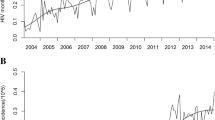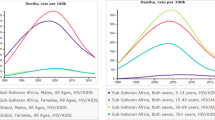Abstract
Objective
To assess patterns of HIV-related mortality by period, gender and age group in Canada from 1987 to 2008.
Methods
We applied standard demographic techniques to assess changes in HIV/AIDS mortality over five time periods: 1987–1991, 1992–1996, 1997–2001, 2002–2006, and 2007–2008. HIV/AIDS-related mortality was based on deaths in which HIV infection or AIDS was reported as the underlying cause of death. Population figures were obtained from annual estimates. Age-, sex- and province-specific crude and standardized HIV/AIDS mortality rates and ratios were used to examine changes in mortality.
Results
In the period from 1987 to 2008, there were 1 7,287 HIV/AIDS-related deaths; of these, 15,587 (90.2%) occurred among men and 1,700 (9.8%) among women. Standardized and age-specific death rates were generally higher in men than women. Among men, rates of mortality were highest in Quebec and British Columbia; and among women, rates increased over time in British Columbia and the Prairies and decreased in Quebec. In general, rates of death were highest in 1992–1996 and lowest in the latest period.
Conclusion
We observed a sharp decline in mortality rates with the introduction of HAART; however, the rates were higher among men in Quebec and British Columbia and among women in British Columbia, Quebec and the Prairies.
Résumé
Objectif
Analyser les courbes de la mortalité liée au VIH par période, par sexe et par groupe d’âge au Canada entre 1987 et 2008.
Méthode
Nous avons appliqué des techniques démographiques standard pour analyser les changements dans la mortalité due au VIH et au sida au cours de cinq périodes: 1987–1991, 1992–1996, 1997–2001, 2002–2006 et 2007–2008. La «mortalité liée au VIH et au sida» désigne les décès pour lesquels l’infection à VIH ou le sida était déclaré(e) comme cause de décès sous-jacente. Nos données démographiques proviennent d’estimations annuelles. Les rapports et les taux (bruts et standardisés) de mortalité due au VIH et au sida selon l’âge, le sexe et la province ont servi à examiner les changements dans la mortalité.
Résultats
Entre 1987 et 2008, il y a eu 17 287 décès liés au VIH et au sida; sur ces décès, 15 587 (90,2 %) sont survenus chez des hommes et 1 700 (9,8 %) chez des femmes. Les taux de mortalité standardisés et par âge étaient généralement plus élevés chez les hommes que chez les femmes. Chez les hommes, les taux de mortalité les plus élevés ont été déclarés au Québec et en Colombie-Britannique; et chez les femmes, les taux ont augmenté au fil du temps en Colombie-Britannique et dans les Prairies et diminué au Québec. Dans l’ensemble, les taux de mortalité les plus élevés ont été observés en 1 992–1996, et les plus faibles, durant la période la plus récente.
Conclusion
Nous avons observé une baisse marquée des taux de mortalité avec l’introduction de la TAHA; cependant, les taux étaient supérieurs chez les hommes au Québec et en Colombie-Britannique et chez les femmes en Colombie-Britannique, au Québec et dans les Prairies.
Similar content being viewed by others
References
Palmer AK, Klein MB, Raboud J, Cooper C, Hosein S, Loutfy M, et al. Cohort profile: The Canadian Observational Cohort collaboration. Int J Epidemiol 2011;40(1):25–32.
Public Health Agency of Canada. Summary: Estimates of HIV prevalence and incidence in Canada, 2008. Available at: https://doi.org/www.phac-aspc.gc.ca/aids-sida/publication/survreport/pdf/estimat08-eng.pdf (Accessed April 7, 2010).
British Columbia Centre for Excellence in HIV/AIDS. Therapeutic guidelines: Antiretroviral treatment of adult HIV infection, 2009. Available at: https://doi.org/www.cfenet.ubc.ca/sites/default/files/uploads/docs/Adult_Therapeutic_Guidelines.pdf (Accessed April 7, 2010).
Harrison KM, Song R, Zhang X. Life expectancy after HIV diagnosis based on national HIV surveillance data from 25 states, United States. J Acquir Immune Defic Syndr 2009;53(1):124–30.
Beck EJ, Mays N, Whiteside AW, Zuniga JM (Eds.). The HIV Pandemic: Local and Global Implications. New York, NY: Oxford University Press, 2006.
Hogg RS, Heath KV, Strathdee SA, Montaner JSG, O’ Shaughnessy MV, Schechter MT. HIV/AIDS mortality in Canada: Evidence of gender, regional and local area differentials. AIDS 1996;10:889–94.
Hogg RS, Schechter MT, Montaner JSG, Goldstone I, Craib K, O’ Shaughnessy MV. Impact of HIV infection and AIDS on death rates in British Columbia and Canada. CMAJ 1994;150(5):711–17.
Weber AE, Hogg RS. Morbidity and mortality related to human immunodeficiency virus in Canadian men and women, 1987–94. Can J Public Health 1999;90(2):127–32.
Statistics Canada. Causes of Death 84-208-XIE. Available at: https://doi.org/www.statcan.gc.ca/bsolc/olc-cel/olc-cel?catno=84-208-x&lang=eng (Accessed August 22, 2011).
US Centers for Disease Control and Prevention. International Classification of Diseases, Ninth Revision (ICD-9), 2009. Available at: https://doi.org/www.cdc.gov/nchs/icd/icd9.htm (Accessed August 22, 2011).
World Health Organization. International statistical classification of diseases and related health problems, 10th revision, 2005. Available at: https://doi.org/apps.who.int/classifications/apps/icd/icdl0online2005/fr-icd.htm (Accessed August 22, 2011).
Statistics Canada. Table 051-0001: Estimates of population, by age group and sex for July 1, Canada, provinces and territories, annual (persons unless otherwise noted). Available at: https://doi.org/cansim2.statcan.gc.ca/cgi-win/cnsmcgi.exe?Lang=E&RootDir=CII/&ResultTemplate=CII/CII_&Array_Pick= 1&ArrayId=0510001 (Accessed August 22, 2011).
Rothman KJ. Modern Epidemiology, 3rd edition. Philadelphia, PA: Lippincott Williams and Wilkins, 2008.
Ahmad OE, Boschi-Pinto C, Lopez AD, Murray CJL, Lozano R, Inoue M. Age Standardization of Rates: A New WHO Standard (GPE Discussion Paper Series: No. 31). Geneva, Switzerland: World Health Organization, 2000.
Hogg RS, Yip B, Kully C, Craib KJP, O’ Shaughnessy MV, Schechter MT, Montaner JSG. Improved survival among HIV-infected patients after initiation of triple-drug antiretroviral regimens. CMAJ 1999;160(5):659–65.
Yoong D. Access and coverage of HIV medications across Canada, 2009. Available at: https://doi.org/www.hivclinic.ca/main/drugs_reimbuse_files/Provincial%20Coverage%20of%20HIV%20medications.pdf (Accessed August 22, 2011).
Krusi A, Wood E, Montaner J, Kerr T. Social and structural determinants of HAART access and adherence among injection drug users. Int J Drug Policy 2010;21:4–9.
Miller CL, Spittal PM, Wood E, Chan K, Schechter MT, Montaner JSG, et al. Inadequacies in antiretroviral therapy use among Aboriginal and other Canadian populations. AIDS Care 2006;18(8):968–76.
Tyndall MW, McNally M, Lai C, Zhang R, Wood E, Kerr T, et al. Directly observed therapy programmes for anti-retroviral treatment amongst injection drug users in Vancouver: Access, adherence and outcomes. Int J Drug Policy 2006;18:281–87.
Public Health Agency of Canada. HIV/AIDS Epi Updates, November 2007. Ottawa, ON: Surveillance and Risk Assessment Division, Centre for Infectious Disease Prevention and Control, PHAC, 2007.
BC Centre for Disease Control. Annual Update Report 2008: HIV and AIDS. Vancouver, BC: STI/HIV Prevention and Control, BCCDC, 2008.
Boulos D, Yan P, Schanzer D, Remis RS, Archibald MD. Estimates of HIV prevalence and incidence in Canada, 2005. Can Commun Dis Rep 2006;32(15):165–74.
British Columbia Vital Statistics Agency. Selected vital statistics and health status indicators. One hundred thirty-eighth Annual report 2009 vital statistics. Victoria, BC: Ministry of Health Services, 2009.
Plitt SS, Gratrix J, Hewitt S, Conroy P, Parnell T, Lucki B, et al. Seroprevalence and correlates of HIV and HCV among injecting drug users in Edmonton, Alberta. Can J Public Health 2010;101(1):50–55.
Au-Yeung CG, Anema A, Chan K, Yip B, Montaner JSG, Hogg RS. Physician’s manual reporting underestimates mortality: Evidence from a populationbased HIV/AIDS treatment program. BMC Public Health 2010;10:64.
Crum NF, Riffenburgh RH, Wegner S, Agan BK, Tasker SA, Spooner KM, et al. Comparisons of causes of death and mortality rates among HIV-infected persons: Analysis of the pre-, early, and late HAART (highly active antiretroviral therapy) eras. J Acquir Immune Defic Syndr 2006;41(2):194–200.
Author information
Authors and Affiliations
Corresponding author
Additional information
Conflict of Interest: None to declare.
Rights and permissions
About this article
Cite this article
Belvedere, L.M., Miller, C.L. & Hogg, R.S. Shifting Sands: Changing Regional and Gender-specific Patterns of HIV/AIDS Mortality in Canada, 1987 to 2008. Can J Public Health 103, 202–206 (2012). https://doi.org/10.1007/BF03403813
Received:
Accepted:
Published:
Issue Date:
DOI: https://doi.org/10.1007/BF03403813




